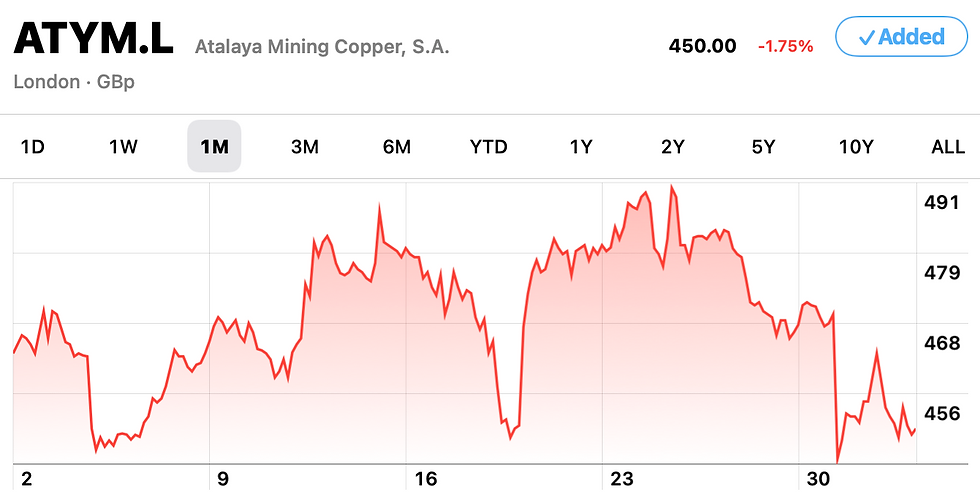Evaluating Atalaya Mining as a Strategic Investment in the Copper Market
- Endsleigh Place
- Aug 2
- 5 min read
Copper is more than just a commodity; it is a vital component for modern technology and energy solutions. With the world moving towards electric vehicles and renewable energy, the demand for copper is set to surge. A recent report from BHP revealed that global copper demand is set to rise by 70% to 50 million tonnes by 2050. This metal is at the forefront of a sustainable future, and Atalaya Mining (ATYM) is strategically positioned to benefit from this growth, making it an appealing investment for those interested in the booming copper sector.
However, investors must navigate near-term market complexities, including projected supply surpluses and evolving trade policies that could significantly impact copper prices and mining company valuations.
Business Quality Assessment
Atalaya Mining has emerged as a significant player in Europe's copper production, particularly in the Iberian Pyrite Belt. The company operates a processing facility with a capacity of 15 million tonnes per annum (Mtpa), which allows it to maintain a strong position in the market. Notably, Atalaya has managed to lower its cash costs from $3.16 per pound to just $2.25 per pound—an impressive 29% reduction that indicates increasingly efficient operations.
In Q1 2025, Atalaya reported a record EBITDA of €52.5 million, highlighting its financial strength. The company boasts a solid balance sheet with a net cash position of €70 million. This financial cushion provides flexibility for operational needs and shields against market volatility.
Put together, these factors demonstrate Atalaya Mining is both operationally sound and financially robust, making it a strong candidate for investment in a sector set to boom over the long term.

Market Dynamics: Navigating Near-Term Headwinds
Supply Surplus Considerations
Despite long-term bullish fundamentals, the International Copper Study Group (ICSG) forecasts a significant copper surplus of 289,000 tonnes in 2025, more than double the 138,000 tonnes surplus from 2024. This surplus is expected to continue into 2026 with 209,000 tonnes, marking three consecutive years of excess supply. The surplus stems from ramping production at major mines like Kamoa-Kakula in the DRC and Oyu Tolgoi in Mongolia, alongside expanded Chinese smelting capacity.
For Atalaya, the near-term surplus environment presents both challenges and opportunities. While copper prices may face downward pressure, the company's low-cost position at $2.25/lb provides significant margin protection against weaker pricing. Additionally, Atalaya's European location offers strategic advantages as the region seeks to reduce dependence on imports amid growing supply chain concerns and geopolitical tensions, particularly concering China. Any future trade barriers in respect to China could restrict long-run supply of copper to the West, which means European copper suppliers at any part of the supply chain could potentially see their positions bolstered.
Tariff Impact Analysis
The implementation of 50% U.S. copper tariffs effective August 1, 2025, has created a two-tier global market with significant implications for copper producers. While these tariffs primarily affect semi-finished products (sparing raw copper cathodes), they've already caused substantial market volatility and inventory dislocations.
The tariff environment presents a competitive advantage for Atalaya as a European producer serving EU markets. The company benefits from:
Reduced competition from non-EU suppliers facing higher U.S. market access costs
Potential supply redirections as global trade flows adjust to tariff barriers
Strategic positioning to serve growing European demand for domestically-produced critical materials
However, investors should note that tariffs have contributed to front-loading of demand in early 2025, which may lead to a demand payback period in the latter half of the year as inventories normalise.
Valuation Analysis
Currently, shares of Atalaya Mining are trading at about 450p. Analysts project that the average target price is 544p, which indicates a potential upside of over 20%. The company's valuation metrics are attractive, with shares trading at just 5.3 times EV/EBITDA compared to sector averages that can exceed 8 times. This suggests that Atalaya may be undervalued based on its operational performance.
Looking ahead, Atalaya aims to produce between 48,000 to 52,000 tonnes in 2025, with a long-term target of 100,000 tonnes annually. This aligns with projections that indicate the copper market will face structural deficits beyond 2026 as the current surplus transitions to scarcity. Moreover, Atalaya is expected to generate around €53 million in operating cash flow, which supports its ability to fund operational expenses and future growth initiatives effectively.
Margin of Safety Discussion
Investors often seek a margin of safety when considering new investments. Atalaya's recent decline of 9% from its peak in July presents an appealing buying opportunity, particularly given the temporary nature of current market headwinds.

Several factors contribute to Atalaya Mining's margin of safety. Its net cash balance of €70 million acts as a financial buffer, which is particularly important during periods of commodity price volatility. Additionally, Atalaya's European operations reduce logistical costs and enhance regulatory stability, making it a more attractive option than companies in less stable regions.
Critical to the investment thesis is recognising that while 2025-2026 may see copper surpluses, the longer-term outlook remains structurally bullish. The International Energy Agency warns of a 30% supply deficit by 2035. This creates a compelling setup where patient investors can benefit from current weakness while positioning for inevitable supply constraints.
Risk Assessment
Despite strong fundamentals, investing in Atalaya Mining carries both traditional commodity risks and new trade-related uncertainties.
Commodity Price Volatility
Current surplus projections suggest copper prices may remain under pressure through 2026. A sustained period of lower prices could impact revenues despite Atalaya's cost advantages.
Trade Policy Uncertainty
While tariffs currently benefit European producers, changing trade policies could alter competitive dynamics. Additionally, potential retaliation measures or trade war escalation could impact global economic growth and copper demand.
Demand Timing Risks
The front-loading of copper purchases ahead of tariffs has created artificial demand that must eventually normalise. This "demand payback" could weaken pricing in H2 2025 and early 2026.
ESG Challenges
Tailings management and environmental compliance remain ongoing concerns, particularly as regulatory scrutiny increases across the mining sector.
While these risks are notable, Atalaya's management has a proven track record of navigating market cycles, and the company's financial strength provides resilience during challenging periods.
Investment Recommendation
After weighing both opportunities and risks, the outlook for Atalaya Mining could lean towards a long-run BUY recommendation for patient, growth-focused investors. While near-term headwinds from surplus supply and tariff-related demand volatility may pressure copper prices, Atalaya's operational excellence and strategic positioning create compelling long-term value.
The investment case rests on timing arbitrage: current market concerns about 2025-2026 surpluses are masking the structural supply constraints emerging post-2026. Atalaya's pathway to 100,000 tonnes annual production aligns perfectly with this timeline, positioning investors to benefit as markets transition from surplus to deficit.
For those considering investing, an effective strategy could involve targeting support price levels around 430-440p to capture an approximate 20% upside potential while maintaining prudent risk management through diversification.
Final Thoughts
Atalaya Mining represents a strategic play on copper's long-term fundamentals while offering downside protection through operational efficiency and financial strength. The current environment of surplus fears and tariff uncertainty has created an attractive entry point for investors willing to look beyond near-term noise.
All things being equal, the company's European production advantage, low-cost operations, and growth pipeline position it to outperform as markets eventually recognise that current surpluses are temporary while structural supply constraints are permanent. For investors seeking exposure to the energy transition and digitalization themes, Atalaya Mining offers a compelling combination of value, quality, and strategic positioning in an essential commodity market.
















Comments